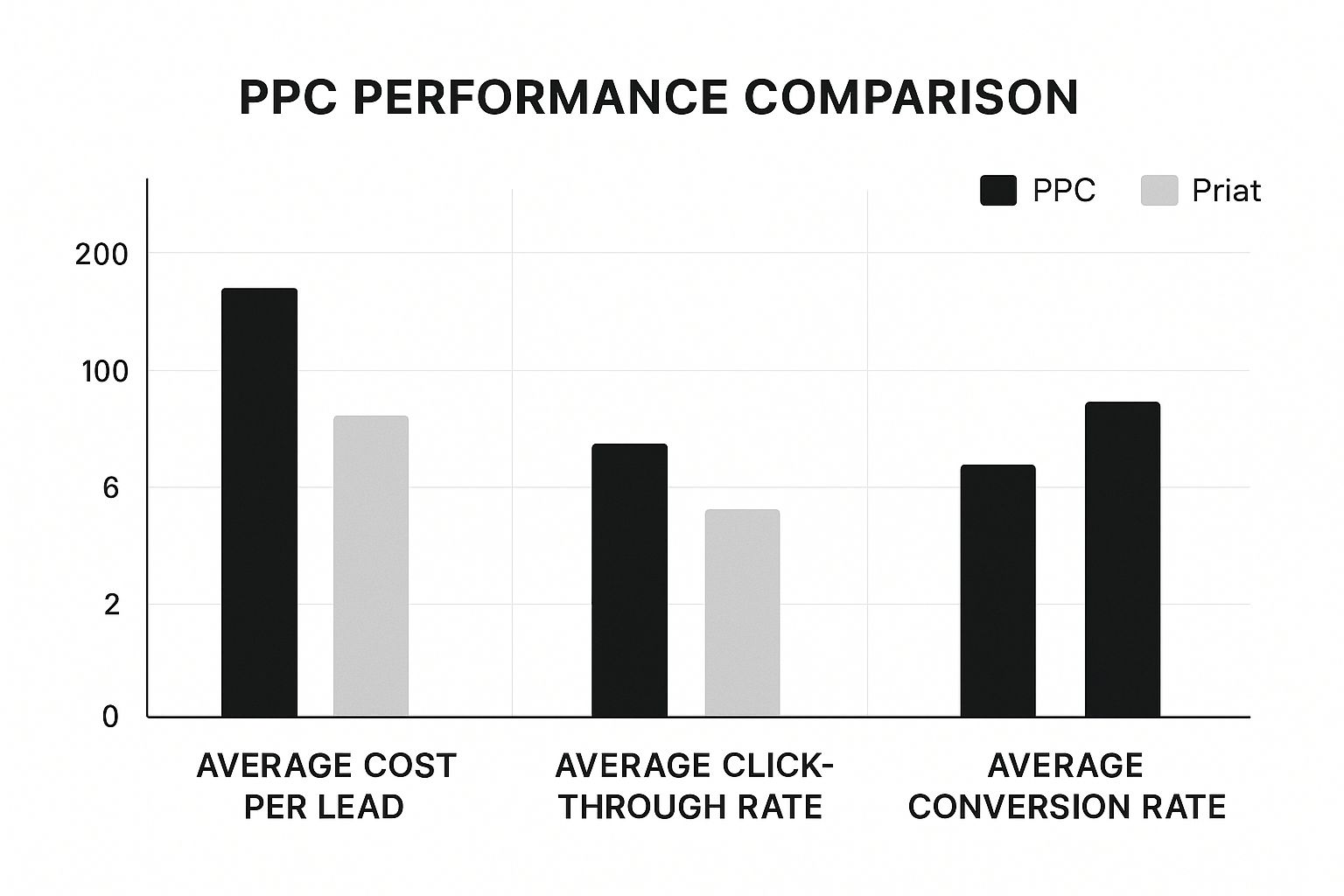In a market where timing is everything, agents use Pay-Per-Click (PPC) advertising to connect with motivated buyers and sellers the moment they start looking.Unlike slower, long-term strategies, PPC done right is the answer for real estate professionals because it delivers immediate, measurable results. A well-tuned campaign isn’t just advertising; it’s a strategic weapon for controlling your lead flow.
The Unfair Advantage of Real Estate PPC

Think of it like this. You could spend all day casting a wide net (like traditional advertising) and just hope for a lucky catch. Or, you could use a high-tech fish-finder that shows you exactly where the most valuable fish are schooling. That fish-finder is your PPC campaign.
PPC advertising is so effective for real estate agents because it’s both precise and cost-effective. It acts like a heat-seeking missile for client intent, placing your brand directly in front of people at the exact moment they search for properties or agents in your market. This isn’t about just getting your name out there; it’s about being the first and best answer when someone is ready to make a move.
To truly understand why PPC is so powerful, it helps to see how it stacks up against more traditional methods you might be using.
PPC vs. Traditional Marketing Quick Comparison
| Attribute | PPC Advertising | Traditional Marketing (e.g., Print, Mailers) |
|---|---|---|
| Speed to Market | Instant. Ads appear as soon as the campaign is live. | Slow. Weeks or months for design, printing, and distribution. |
| Targeting | Hyper-specific. Target by location, keyword, demographics, and user behavior. | Broad and generalized. Based on zip codes or mailing lists. |
| Measurability | Highly measurable. Track every click, lead, cost, and ROI in real-time. | Difficult to measure. Hard to know who saw the ad and took action. |
| Flexibility | Extremely flexible. Adjust budgets, ads, and targeting on the fly. | Inflexible. Once printed or mailed, changes are impossible. |
| Cost Control | Total control. Set daily budgets and pay only when someone clicks. | Fixed upfront costs. Pay for the entire campaign regardless of results. |
This side-by-side view makes it clear: PPC offers a level of control and precision that older methods simply can’t match.
Capturing High-Intent Leads Instantly
While other marketing efforts like building your social media presence or focusing on SEO for real estate agents build momentum over the long haul, PPC offers instant gratification. The moment your campaign goes live, you can appear at the very top of Google search results for your most valuable keywords.
This speed is crucial in real estate, where a prospect’s motivation is highest right when they begin their search. By grabbing their attention immediately, you insert yourself into their decision-making process before your competitors even know they exist. This is why PPC is a primary driver of high-quality leads.
PPC advertising isn’t just another marketing channel; it’s a strategic system for manufacturing opportunities on demand. You decide when and where you want to find new clients, and a well-optimized campaign makes it happen.
This degree of control is a game-changer. You aren’t just waiting for referrals or hoping your mailer lands in the right hands at the right time. Instead, you’re actively targeting individuals who have raised their digital hand to say, “I’m interested in buying or selling a home now.”
This proactive approach is the core reason why pay per click done right is the answer for real estate professionals who want to scale their business predictably.
Translating PPC Metrics into Real Estate Wins
It’s easy to look at a PPC dashboard and see a jumble of numbers. But to really grasp why pay-per-click, when done right, is a game-changer for real estate agents, you have to connect those numbers to what actually matters: new clients and commission checks. This means looking beyond the simple data points and digging into the metrics that reveal the true financial impact of your campaigns.
Many agents get hung up on a low Cost Per Click (CPC), but let’s be honest—a cheap click from someone who isn’t serious is a wasted dollar. The goal isn’t just to get any clicks; it’s to attract the right clicks from motivated buyers and sellers who are ready to talk. This is where you have to understand how all the different metrics work together.
Beyond Clicks to Commissions
Think of your PPC data as a story about your marketing investment. A high Click-Through Rate (CTR) tells you your ad is hitting the mark and grabbing the attention of your target audience. A low Cost Per Acquisition (CPA)—the price you pay for one lead—signals that your campaign is running efficiently.
However, in the world of real estate, even a seemingly high CPA can be incredibly profitable. Let’s say you spend $500 on a campaign. If that investment brings in just one quality seller lead that turns into a $10,000 commission, your $500 CPA suddenly looks like a brilliant move. If you only focused on getting the lowest CPA possible, you might completely miss out on the more competitive (and valuable) keywords that serious clients are searching for.
This chart really drives home how PPC stacks up against other common marketing channels.

As you can see, the data points to PPC having a clear advantage in driving higher engagement and conversions, making it a much more direct and efficient way to generate solid leads.
Understanding the Benchmarks
So, how do you know if your numbers are any good? Comparing them to industry averages gives you a solid frame of reference.
For real estate, the numbers are quite encouraging:
- Google Search ads average a very reasonable $2.37 per click.
- The average click-through rate is an impressive 6.19%.
- While the average cost per lead hovers around $116, this is the kind of investment that separates the top producers from everyone else. Why? Because these ads capture people with incredibly high intent to buy or sell.
The most successful agents don’t see PPC as a marketing expense. They see it as a direct investment in acquiring their most valuable assets: clients. Every click and every lead is one step closer to another successful closing.
At the end of the day, it all comes down to connecting your ad spend directly to your bottom line. The single most important metric for this is your Return on Ad Spend (ROAS). It’s the true measure of your campaign’s success. This is what shifts the conversation from “How much did it cost?” to “How much did it make?”—and that’s where you find real success.
If you’re curious about how your own campaigns measure up, you can calculate return on ad spend using our guide to get a clear picture of your profitability.
Building Your High-Conversion PPC Campaign

Alright, let’s move from theory to action. A truly successful PPC campaign isn’t just one thing; it’s a machine built on three core pillars. When these elements work in harmony, they create a seamless journey that turns a casual Google search into a qualified lead. If you can master these, you’ll have a system that builds real connections, not just a list of empty clicks.
Pillar 1: Hyper-Local Keyword Targeting
First things first: you have to get laser-focused with your keywords. Throwing money at broad terms like “homes for sale” is like shouting into a hurricane—it’s loud, expensive, and gets you nowhere.
You need to think exactly like your ideal client. What are they actually typing into that search bar? They’re using phrases like “condos for sale in south loop chicago” or “four-bedroom homes near Lincoln Park.” These aren’t just keywords; they’re signals of high intent from someone deep into their search.
This specificity is what makes PPC advertising a powerful tool for real estate professionals due to its cost-effectiveness. By zeroing in on these longer, more descriptive “long-tail” keywords, you attract a much more qualified audience and stop wasting your ad budget on people who aren’t serious.
Pillar 2: Ad Copy That Actually Converts
Your second pillar is compelling ad copy. A great ad doesn’t just list a property’s features. It solves a problem or speaks directly to a dream. It has to instantly answer the searcher’s question and give them an undeniable reason to click your link over all the others.
So, instead of a boring, generic headline, try something that connects on a human level. For example:
- “Find Your Dream Home Today” hits on their ultimate goal and aspiration.
- “Get a Free Home Valuation in Minutes” offers instant, tangible value to a potential seller.
- “Exclusive Listings in Downtown Austin” creates a feeling of scarcity and unique opportunity.
This is precisely why pay per click done right is the answer for real estate professionals. Your ad needs to resonate with the user’s specific goal to cut through the noise of a crowded search page.
Your ad is the digital handshake that introduces you to a potential client. Make it firm, confident, and focused entirely on their needs.
And the data backs this up. Industry benchmarks show that real estate PPC campaigns can hit click-through rates as high as 9.09%, blowing past the average for other industries. A huge part of that success comes down to local relevance—after all, a whopping 80% of consumers say they prefer ads tailored to their city or neighborhood. You can dig deeper into these powerful real estate benchmarks on Promodo.com.
Pillar 3: The Dedicated Landing Page
This brings us to the third and, frankly, most critical pillar: the dedicated landing page. Sending all your hard-won PPC traffic to your general homepage is one of the most common and costly mistakes you can make. Think about it: a person who clicked an ad for “South Loop condos” needs to land on a page only about South Loop condos—not your agent bio or a list of every service you offer.
Your landing page must have one single, solitary job: capture the lead. That’s it. To do that, it needs:
- A bold headline that perfectly matches the ad they just clicked.
- High-quality photos or a quick video of relevant properties.
- A dead-simple contact form that’s easy to fill out.
- Absolutely no distracting links or navigation menus that might tempt them to click away.
This focused approach creates a smooth, frictionless path from their search to your CRM. Each pillar supports the next, building a high-conversion machine that can predictably fuel your business’s growth.
Using Advanced Targeting to Find Ideal Clients
Getting past basic keyword searches is where the best real estate agents really start to pull away from the competition. Advanced targeting is the key. It’s how you stop shouting into the void and start speaking directly to your perfect client, right when they need you. This is the shift that turns an advertising budget from an expense into a true lead-generating machine.
Think about this: what if you could show your ad to someone the exact moment they walk into a competitor’s open house? That’s not science fiction; it’s geo-fencing. You can literally draw a virtual circle around a specific property—say, a new development or another agent’s listing—and target anyone whose smartphone enters that zone. It’s an incredibly direct way to connect with motivated buyers who are actively looking at homes in your area.
Re-Engaging Warm Leads with Remarketing
Here’s another powerful tool for your arsenal: remarketing. What happens to all those people who visit your website, click through a few listings, and then disappear? They aren’t lost causes. They’re warm leads. Remarketing lets you gently “follow” these visitors around the internet, showing them ads on other websites and social media to keep your name front and center.
This tactic works so well because you’re reaching out to people who have already raised their hand and shown interest. A well-placed remarketing ad can be the perfect reminder that brings them back to your site when they’re finally ready to get serious. This is a core reason why pay per click done right is the answer for real estate professionals who want an efficient path from browser to buyer.
Advanced targeting isn’t about finding more people. It’s about finding the right people, over and over again, at the exact moment your expertise matters most to them.
The numbers back this up. A full 62% of marketers are boosting their PPC budgets because of how effective these targeted campaigns are. And with 52% of real estate PPC clicks coming from mobile devices, location-based strategies like geo-fencing are more powerful than ever. Sure, the median cost per click sits around $2.37, but targeting high-intent sellers with phrases like ‘sell my house fast’ might cost more upfront while delivering incredibly qualified leads. You can dig into more of these insightful real estate marketing statistics and their impact on ElectroIQ.com.
Building Custom Audiences for Pinpoint Accuracy
Beyond just where people are, you can build audiences based on what’s happening in their lives. Platforms like Facebook let you find people who are ‘recently married,’ ‘expecting a child,’ or even those who fall into certain income brackets. Big life changes are often the biggest drivers for buying or selling a home.
When you create a strategy that spans multiple platforms, you can connect with people whose online activity signals an upcoming move, no matter where they are online. This approach blends the clear buying intent people show on Google with the rich demographic and behavioral data available on social media. It’s a vital part of any solid marketing plan, much like the broader concepts we cover in our guide to digital marketing for small business. This is how you build a reliable, predictable system for bringing new clients through your door.
Smart Budgeting for Sustainable PPC Growth

So, let’s get down to the question on every agent’s mind: “What’s this actually going to cost me?” Smart budgeting isn’t about pinching pennies. It’s about investing your money where it counts to drive predictable growth without taking on a bunch of financial stress.
This is exactly why PPC advertising is such a powerful tool for real estate agents. It’s incredibly cost-effective when you do it right. The trick is to stop thinking of PPC as just another marketing expense and start seeing it as a direct investment in acquiring high-value clients. You’re not just buying ads; you’re buying clear, measurable opportunities to connect with people who are ready to buy or sell.
Setting Your Initial PPC Budget
Your starting budget needs to be grounded in reality—your goals and your specific market. It’s no surprise that a competitive city like Austin will demand a bigger investment than a smaller suburban town. One of the best features of platforms like Google Ads is that you can set daily budget caps. This simple tool is your safety net, ensuring you never accidentally overspend while you’re figuring out what works.
This control is huge. It means you can start small, gather incredibly valuable data, and then scale up once you’ve pinpointed the keywords and campaigns that are actually making your phone ring. This data-first approach is the secret to figuring out how to improve your marketing ROI month after month.
Allocating Your Funds Intelligently
A winning PPC strategy is more than just a single, generic campaign. You need to be strategic with how you divvy up your funds. Think of it like a financial portfolio—you diversify to minimize risk and maximize returns. The same logic applies here. You should split your budget across different campaigns designed to attract clients at various stages of their real estate journey.
A well-managed PPC budget is a predictable engine for commission growth. You decide how much fuel to add, and the system delivers measurable results.
To give you a clearer picture, here’s a simple breakdown of how a real estate agent might allocate a monthly PPC budget.
Sample Monthly PPC Budget Allocation
This table shows a hypothetical budget breakdown, illustrating how you can allocate funds across different campaign types to cover all your bases.
| Campaign Type | Target Audience | Keyword Focus | Suggested Budget % |
|---|---|---|---|
| Buyer Leads | First-time buyers, relocators | “homes for sale in [your city]” | 40% |
| Seller Leads | Homeowners considering selling | “what is my home worth” | 35% |
| Brand Awareness | Local residents, past clients | Your name, brokerage name | 15% |
| Remarketing | Past website visitors | N/A (Audience-based) | 10% |
This kind of balanced approach ensures you’re doing more than just chasing hot leads. You’re also building your local brand presence and staying top-of-mind with people who have already shown interest. By treating your budget like a portfolio, you can continuously shift funds toward your top-performing campaigns, guaranteeing your marketing dollars are always working as hard as you are.
Answering Your Top Real Estate PPC Questions
Stepping into the world of pay-per-click advertising can feel like navigating a new city—it’s exciting, but you’re bound to have some questions. Let’s clear up a few of the most common ones I hear from agents all the time.
How Much Should a New Agent Really Budget for PPC?
There’s no one-size-fits-all answer here, but I always tell new agents to start with a budget they’re comfortable testing. For most, that sweet spot is somewhere between $500 to $1,000 per month, especially in a market with average competition.
Why that range? It’s not just a number pulled out of thin air. It’s enough of an investment to start gathering real, actionable data. You’ll quickly learn which keywords are hitting the mark, what ad copy resonates with buyers or sellers, and who you should be targeting.
Think of it as your initial discovery phase. The goal isn’t to dominate Google on day one, but to make a smart investment in learning what actually works for your business. Once you find that winning formula, you can scale your budget with confidence. This is a perfect example of why PPC advertising is a powerful tool for real estate professionals due to its cost-effectiveness; you’re in complete control of the spend.
What’s a Good Conversion Rate to Aim For?
In real estate PPC, a solid benchmark for a “good” conversion rate is anywhere from 2% to 5%. In simple terms, for every 100 people who click on your ad, you should be generating two to five legitimate leads who either call you or fill out a form.
But here’s the thing: that percentage doesn’t tell the whole story. The quality of your leads is far more important than the quantity. One incredible lead that turns into a $400,000 home sale is worth infinitely more than a dozen low-quality leads that never pan out.
Remember, the real goal isn’t just to collect names and numbers. It’s to kickstart meaningful conversations that end in closed deals and commissions. A lower conversion rate made up of high-intent clients is always a bigger win.
How Long Before I See Actual Results?
This is the beauty of PPC—it works faster than almost anything else out there. You can have a campaign live and see traffic hitting your website within hours. But when we talk about “real results,” meaning a steady stream of quality leads, you should give it about 30 to 90 days.
This initial period is your proving ground. It’s when the magic happens—you’ll be tweaking your ad copy, adjusting your bids to stay competitive, and building a list of negative keywords to weed out the tire-kickers. This is exactly why pay per click done right is the answer for real estate professionals who are serious about predictable growth.
Ready to build a PPC strategy that delivers real, measurable results? The experts at ReachLabs.ai can create a data-driven campaign tailored to your market and goals, turning your ad spend into a powerful engine for growth. Learn how we can help you at https://www.reachlabs.ai.





